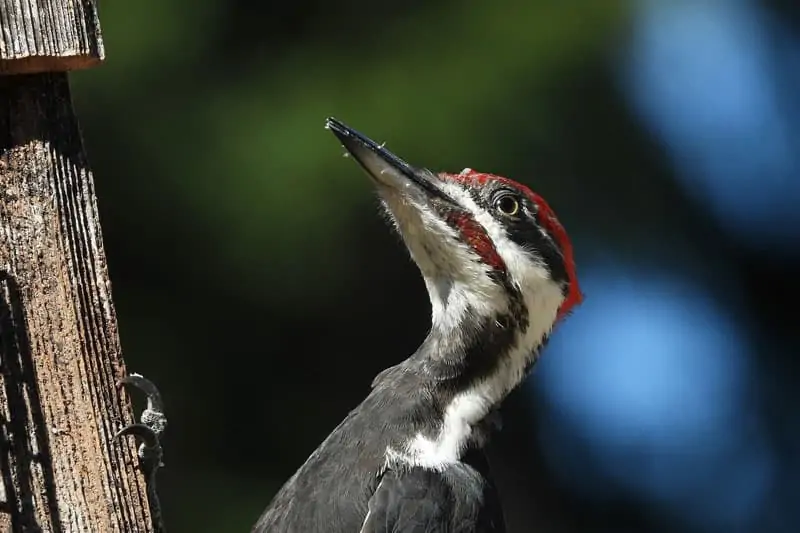You’re in luck if you’ve ever wondered about the different types of woodpeckers found in Maine. Maine woodpeckers are the subject of this article. For the next time you see or hear one of these magnificent birds, we’ll look at some photographs and learn some interesting facts!
Maine’s seven most frequent woodpecker species are the Downy, Hairy, Northern Flicker, Pileated, Yellow-bellied Sapsucker, Three-toed, and Black-backed Woodpeckers; you may have trouble finding a different wandering migrant species.

Let’s take a look at each of Maine’s species in detail.
7 TYPES OF WOODPECKER IN MAINE
1. DOWNY WOODPECKER
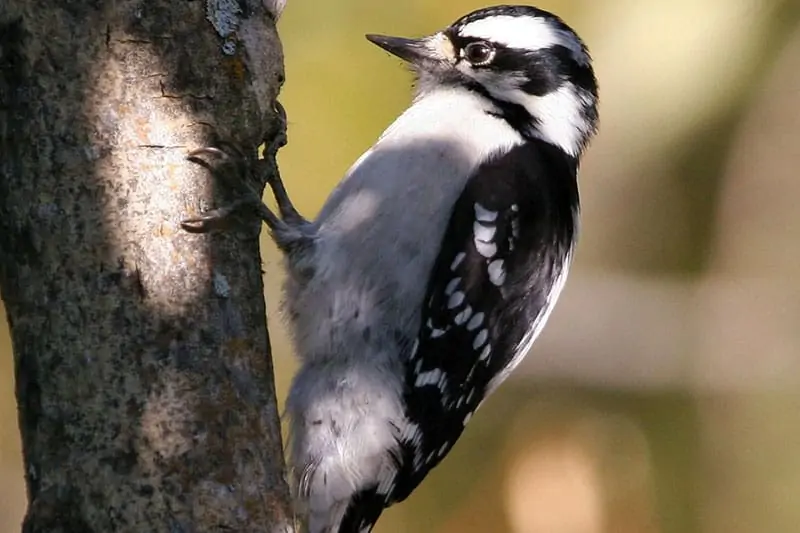
Scientific name: Picoides pubescens
Length: 5.5-6.7 in
Weight: 0.7-1.0 oz
Wingspan: 9.8-11.8 in
The Downy Woodpecker, which may be found virtually anywhere trees are present, is the smallest and most prevalent of Maine’s woodpeckers. Locals affectionately refer to them as “downies,” and it’s named for the delicate texture on their backs.
Their back is striped in black and white, with wide horizontal stripes on their wings, and they have a very unique pattern. The males have a bright red dot on the backs of their heads, which distinguishes them from females.
The majority of this woodpecker’s time is spent clinging to tree trunks and branches. Unlike most species of birds that have three forward and one back, they’ve evolved zygodactyl feet, which means they have two toes facing forward and two toes facing backward.
This enables them to better search for insects by clinging to the tree. Since they can crawl all the way out to the tips of smaller branches that other woodpeckers cannot, their smaller size comes in handy when foraging.
2. HAIRY WOODPECKER
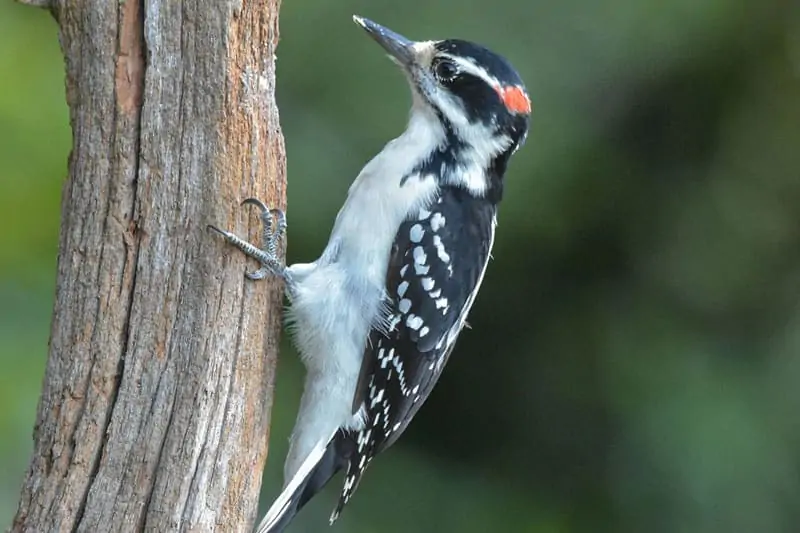
Scientific name: Picoides villosus
Length: 7.1-10.2 in
Weight: 1.4-3.4 oz
Wingspan: 13.0-16.1 in
With its black and white stripe and red dot, the Hairy Woodpecker looks a lot like the Downy Woodpecker, but they are two separate species! The hairy has all-white outer tail feathers, as well as a larger beak than the Downy.
It prefers mature woods with ancient tree development, unlike the Downy. Insects are the most common food, but plant matter is sometimes included.
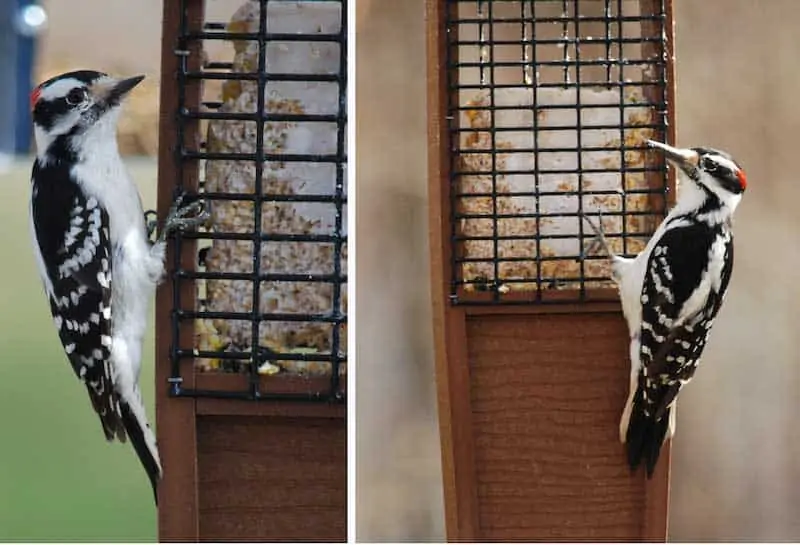
In search of easy food, this woodpecker is well known for hanging around near the sounds of Pileated Woodpeckers. The Hairy Woodpecker will check the deep holes as the Pileated walks by and pick up any insects that were missed.
They may also drink sap seeping from the wells left in the bark, which is how Sapsuckers get their name. They’ve also been spotted pecking into sugar cane for the juice, which suggests they have a sweet tooth.
3. NORTHERN FLICKER

Scientific name: Colaptes auratus
Length: 11.0-12.2 in
Weight: 3.9-5.6 oz
Wingspan: 16.5-20.1 in
Maine’s only gray-brown woodpecker is the Northern Flicker, which differs from the standard black and white coloration. Its wings have been observed to flash yellow from below while in flight. It is a frequent sight at bird feeders around the state, preferring woodlands, wetlands, and other built-up places.
When insects and other invertebrates are available, this bird will eat them, but it will also eat seeds and berries. The most frequent way to observe this species is to see it walking vertically up a tree trunk.
Its zygodactyl feet give it balance, and its stiff, pointed tail feathers protrude at just the correct angle to function as a balancing aid. In the spring, when they’re most active, watch for Northern Flickers in Maine’s breeding range.
4. PILEATED WOODPECKER

Scientific name: Dryocopus pileatus
Length: 15.8-19.3 in
Weight: 8.8-12.3 oz
Wingspan: 26.0-29.5 in
When you say “woodpecker,” the Pileated Woodpecker is most likely the one that comes to mind. Whether you’re seeing this crow-sized bird for the first time or you’ve seen it a thousand times, it’s a delight to watch! With its bright red crest and striking black body, it’s a treat to see.
When you have a Pileated Woodpecker around, it’s clear. They leave distinctive rectangular holes in the trees it digs up in search of carpenter ants, which is their principal source of food. As the biggest woodpeckers in Maine and North America, they leave huge holes.
This woodpecker prefers dead and softer wood while looking for ant nests, going so far as to rip apart stumps and huge sections of fallen trees, unlike the common misconception that they hammer into live trees in search of insects. The drumming sound of this woodpecker is also unique, with slowdowns, accelerations, and accelerations.
5. YELLOW-BELLIED SAPSUCKER

Scientific name: Sphyrapicus varius
Length: 7.1-8.7 in
Weight: 1.5-1.9 oz
Wingspan: 13.4-15.8 in
During the breeding season, the Yellow-bellied Sapsucker may only be found in Maine. Because of its cat-like cries and staccato drumming in the spring, it is considered to be one of the most vociferous woodpeckers.
The Sapsucker drills tiny holes in evenly spaced rows of tree bark, and returns to them to feed on the sap that seeps out at regular intervals. Many insect species, such as ants, prefer to eat this sap because it serves as an attractor. In a more “woodpecker” style, they still harvest insects from tree trunks, albeit they aren’t limited to it.
6. AMERICAN THREE-TOED WOODPECKER
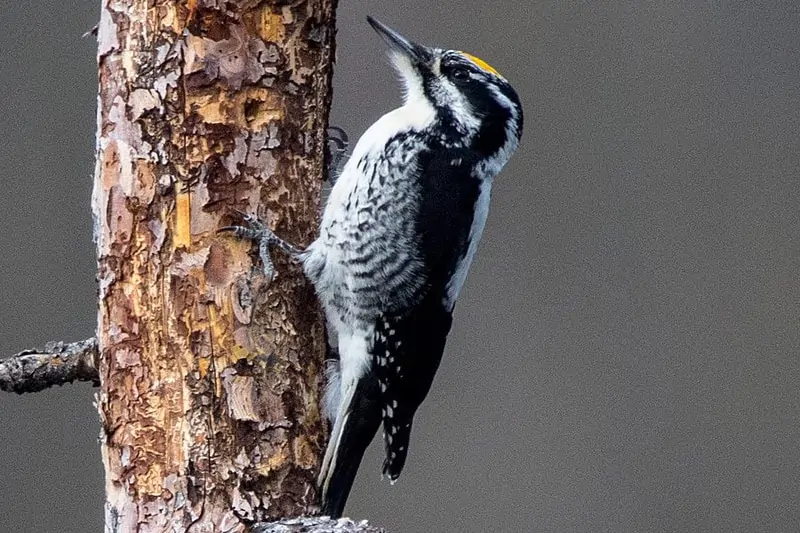
Scientific name: Picoides dorsalis
Length: 8.3-9.1 in
Weight: 1.6-2.4 oz
Wingspan: 14.6-15.3 in
You may see a Three-toed Woodpecker in the most northwestern sections of Maine. They’re not particularly frequent, and their diminutive size and lack of color make finding them difficult.
Three-toed Woodpeckers commonly remain perched on a solitary tree for lengthy periods of time, either sitting motionless or removing the bark. These woodpecker don’t need to bore or dig holes in trees like most woodpeckers, instead they use their bills to peel the bark off.
Between the size of a Downy and Hairy Woodpecker, American Three-toed Woodpeckers are about the size of an American Robin. To help them pick off bark, their bills are fairly short but tough and sturdy. They have fine black barring on their white undersides, and they’re mostly black and white. Males have a yellow patch on their foreheads that is dull.
7. BLACK-BACKED WOODPECKER

Scientific name: Picoides arcticus
Length: 9.1 in
Weight: 2.1-3.1 oz
Wingspan: 15.8-16.5 in
Northern Maine is home to the black-backed woodpecker. In regions where both species of woodpeckers live, these woodpeckers are commonly the dominant species and will drive away American Three-toed Woodpeckers from their areas.
The size of a Black-backed Woodpecker is comparable to that of a Hairy Woodpecker. They have less barring on the back and wings than the Three-toed Woodpecker in America, although they are similar in coloration. In forests where wildfires had occurred, the solid black plumage on their backs aids them blend in with charred trees.
These burnt regions attract Black-backed Woodpeckers, who will spend years in these regions feasting on wood-boring beetle larvae and other insects.
HOW TO ATTRACT WOODPECKERS
Attracting woodpeckers to our feeders or yards is something we all enjoy for a few reasons. They bring a bit of excitement to the table, just like chickadees, titmice, or cardinals. They’re also more difficult to see and attract, though. Here are some tips on how to entice woodpeckers to visit your yard.
- Many types of woodpeckers are known for visiting bird feeders, so offer them food they prefer. Consider placing a suet feeder alongside your black sunflower seed offering. To entice bigger woodpeckers, make sure to get a suet feeder with a tail prop section.
- Woodpeckers prefer dead and dying trees with plenty of insect larvae for them to eat, so leave dead trees alone.
- Many woodpecker species will use nest boxes. From May to July, pileated woodpeckers utilize nesting boxes.
- Woodpeckers may occasionally eat fruits and berries such as dogwood, serviceberry, tupelo, mountain ash, strawberry, cherry, grapes, bayberry, holly, blueberries and apples.
- Remember that water is necessary for woodpeckers, as it is for all birds; provide them with a water source, preferably one with a water mover or solar fountain. Since the fountain doesn’t stop every time the sun goes behind a cloud, solar fountains with batteries tend to work best.
